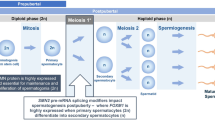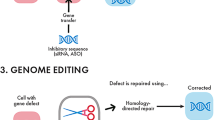Abstract
The expansion of trinucleotide repeat sequences underlies a number of hereditary neurological disorders. To study the stability of a trinucleotide repeat and to develop an animal model of one of these disorders, spinal and bulbar muscular atrophy (SBMA), we have generated transgenic mice carrying either the normal or expanded repeat human androgen receptor (AR) gene. Unlike the disease allele in humans, the AR cDNA containing the expanded repeat in transgenic mice showed no change in repeat length with transmission. Expression of the SBMA AR was found in transgenic mice, but at a lower level than normal endogenous expression. The lack of a physiological pattern of expression may explain why no phenotypic effects of the transgene were observed.
Similar content being viewed by others
References
La Spada, A.R., Wilson, E.M., Lubahn, D.B., Harding, A.E. & Fischbeck, K.H. Androgen receptor gene mutations in X-linked spinal and bulbar muscular atrophy. Nature 352, 77–79 (1991).
Macdonald, M.E. et al. A novel gene containing a trinucleotide repeat that is expanded and unstable on Huntington's disease chromosomes. Cell 72, 971–983 (1993).
Orr, H.T. et al. Expansion of an unstable trinucleotide CAG repeat In spinocerebeilar ataxia type-1. Nature Genet. 4, 221–226 (1993).
Koide, R.T. et al. Unstable expansion of CAG repeat in hereditary dentatorubral-pallldoluysian atrophy (DRPLA). Nature Genetics 6, 9–13 (1994).
Sobue, G. et al. X-linked recessive bulbospinal nueronopathy. A clinicopathological study. Brain 112, 209–232 (1989).
La Spada, A.R. et al. Meiotic stability and genotype-phenotype correlation of the trinucleotide repeat In X-linked spinal and bulbar muscular atrophy. Nature Genet. 2, 301–304 (1992).
Biancalana, V. et al. Moderate Instability of the trinucleotide repeat in spino-bulbar muscular atrophy. Hum. molec. Genet 1, 255–258 (1992).
Igarashi, S. et al. Strong correlation between the number of CAG repeats in androgen receptor genes and the clinical onset of features of spinal and bulbar muscular atrophy. Neurology 42, 2300–2302 (1992).
Doyu, M. et al. Severity of X-linked recessive bulbospinal neuronopathy correlates with size of the tandem CAG repeat in androgen receptor gene. Ann. Neurol. 32, 707–710 (1992).
Arnheiter, H., Skuntz, S., Noteborn, M., Chang, S. & Meier, E.S. Transgenic mice with intra cellular immunity to Influenza virus. Cell 62, 51–61 (1990).
Forss-Petter, S. et al. Transgenic mice expressing beta-galactosidase in mature neurons under neuron-specific enolase promoter control. Neuron 5, 187–197 (1990).
He, W.W. et al. Molecular cloning of androgen receptors from divergent species with a polymerase chain reaction technique: complete cDNA sequence of the mouse androgen receptor and isolation of androgen receptor cDNA probes from dog, guinea pig and clawed frog. Biochem. Biophys. Res. Commun. 171, 697–704 (1990).
Husmann, D.A., Wilson, C., McPhaul, M.J., Tilley, W.D. & Wilson, J.D. Antipeptlde antibodies to two distinct regions of the androgen receptor localize the receptor protein to the nuclei of target cells in the rat and human prostate. Endocrinology 126, 2359–2368 (1990).
He, W.W., Kumar, M.V. & Tindall, D.J. Aframe-shift mutation in the androgen receptor gene causes complete androgen insensitivity in the testicular-feminized mouse. Nucl. Acids Res. 19, 2373–2378 (1991).
Fishel, R. et al. The human mutator gene homolog msh2 and its association with hereditary nonpolyposis colon-cancer. Cell 75, 1027–1038 (1993).
Strand, M., Prolla, T.A., Liskay, R.M. & Petes, T.D. Destabilization of tracts of simple repetitive DNA in yeast by mutations affecting DMA mismatch repair. Nature 365, 274–276 (1993).
Richards, R.I., Holman, K., Yu, S. & Sutherland, G.R. Fragile X syndrome unstable element, p(CGG)n, and other simple tandem repeat sequences are binding sites for specific nuclear proteins. Hum. molec. Genet. 2, 1429–1435 (1993).
Mhatre, A.N. et al. Reduced transcriptional regulatory competence of the androgen receptor in x-llnked spinal and bulbar muscular-atrophy. Nature Genet. 5, 184–188 (1993).
Sar, M. & Stumpf, W.E. Androgen concentration in motor neurons of cranial nerves and spinal cord. Science 197, 77–79 (1977).
Forger, N.G., Hodges, L.L., Roberts, S.L. & Breedlove, S.M. Regulation of motoneuron death in the spinal nucleus of the bulbocavemosus. J. Neurobiol. 23, 1192–1203 (1992).
Araki, I., Harada, Y. & Kuno, M. Target-dependent hormonal control of neuron size in the rat spinal nucleus of the bulbocavernosus. J. Neurosci. 11, 3025–3033 (1991).
Fishman, R.B. & Breedlove, S.M. Local perineal implants of antiandrogen block masculinlzation of the spinal nucleus of the bulbocavemosus. Devel. Brain Res. 70, 283–286 (1992).
Willems, P.J. Dynamic mutations hit double figures. Nature Genet. 8, 213–215 (1994).
Simental, J.A., Star, M., Lane, M.V., French, F.S. & Wilson, E.M. Transcriptional activation and nuclear targeting signals of the human androgen receptor. J. biol. Chem. 266, 510–518 (1991).
Palmiter, R.D. & Brinster, R.L. Germ-line transformation of mice. A. Rev. Genet. 20, 465–499 (1986).
Sanger, F., Niklen, S. & Coulson, R. DNA sequencing with chain-terminating inhibitors. Proc. natn. Acad. Sci. U.S.A. 74, 5463–5467 (1977).
Author information
Authors and Affiliations
Rights and permissions
About this article
Cite this article
Bingham, P., Scott, M., Wang, S. et al. Stability of an expanded trinucleotide repeat in the androgen receptor gene in transgenic mice. Nat Genet 9, 191–196 (1995). https://doi.org/10.1038/ng0295-191
Received:
Accepted:
Issue Date:
DOI: https://doi.org/10.1038/ng0295-191
- Springer Nature America, Inc.
This article is cited by
-
Mouse Models of Polyglutamine Diseases: Review and Data Table. Part I
Molecular Neurobiology (2012)
-
Features of trinucleotide repeat instability in vivo
Cell Research (2008)
-
The GAA triplet-repeat is unstable in the context of the human FXN locus and displays age-dependent expansions in cerebellum and DRG in a transgenic mouse model
Human Genetics (2006)
-
Real-Time PCR Analysis of Trinucleotide Repeat Allele Expansions in the Androgen Receptor Gene
Molecular Diagnosis (2005)
-
Modelling brain diseases in mice: the challenges of design and analysis
Nature Reviews Genetics (2003)





